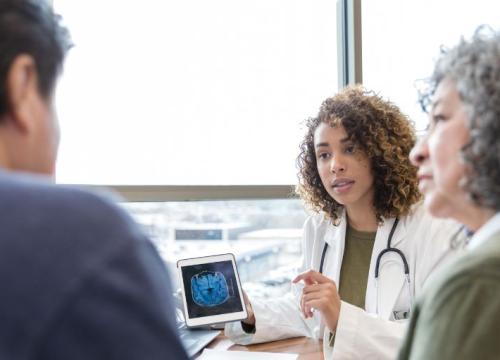Studying the Intersection of Movement and Cognitive Disorders to Better Understand Parkinson’s Disease

Chi-Ying Lin, MD, MPH, is researching how movement and non-movement symptoms intersect for people with Parkinson’s disease (PD) and Alzheimer’s disease. Through studying these symptoms in people with movement disorders and cognitive disorders, he hopes to learn more about what parts of the brain produce specific symptoms, which could lead to new treatments for people with Parkinson’s.
Following his Parkinson’s Foundation fellowship at Columbia University Irving Medical Center, Dr. Lin is now an assistant professor of neurology at Baylor College of Medicine with dual appointments in the Alzheimer’s Disease and Memory Disorders Center and the Parkinson’s Disease Center and Movement Disorders Clinic, which is a Parkinson’s Foundation Center of Excellence. We spoke to Dr. Lin to learn more about his work and what he finds most promising in current Parkinson’s research.
What led you to Parkinson’s research?
I was very interested in the personalization of Parkinson’s evaluation and treatment plans, and in learning more about how movement and cognitive symptoms intersect.
I came to the United States after my residency in Taiwan because I was interested in neuropathology at Columbia University. When I arrived, I had a chance to hear Dr. Stanley Fahn speak about movement disorders and it blew me away. I decided I wanted additional training in movement disorders. Because of the excellent clinical training and mentorship opportunities in the U.S., I decided to restart my career here, which led me to my residency at Mount Sinai and my fellowship at Columbia University Irving Medical Center, which was supported by the Parkinson’s Foundation.
Why research the intersection of movement disorders and cognitive disorders?
In my first exposure to cognitive disorders in Taiwan, I was not entirely aware that people with movement disorders actually have a lot of cognitive issues. At Columbia University, I learned through the Parkinson’s Foundation that around 50% of people with PD could have either mild cognitive impairment or dementia. I felt it was important to study this intersection, which is a relatively new field.
There is a brain region called the cerebellum that sits right behind the brainstem and above the neck. It used to be thought of as a pure motor organ and was often studied to understand movement. However, in the past 10 years, there has been an increased understanding that the cerebellum controls non-movement symptoms as well.
Getting To Know the Brain
The cerebellum, which means “little brain,” is primarily responsible for coordination of movement, maintaining posture and balance, muscle tone and motor learning. Recent research also started to reveal the role of cerebellum in non-movement symptoms.
The basal ganglia is an interconnected group of brain structures that control movement, thinking and emotions.
Can you tell us about your impulse control study?
In my fellowship, I conducted studies, and one primarily focused on the intersection of movement and cognitive disorders, especially for impulsivity and compulsivity, which are commonly seen in people with Parkinson’s. This study compared impulsivity in people with Parkinson’s to people with a different cognitive condition, Cerebellar Ataxia, which can include impulsive behavioral symptoms as well.
Our findings determined that impulsivity was different between the two conditions, and with Parkinson’s disease, it can be more widespread to include several impulsive behaviors that are both movement and non-movement related, including gambling, eating, hypersexuality, spending and compulsively taking medication. This suggests that that cerebellum and basal ganglia, a different part of the brain that is affected by PD, can produce different kinds of impulsive behaviors, furthering our understanding of how the cerebellum functions.
What are you currently researching?
The goal of my current study is to better understand the genetic and environmental factors that lead to Alzheimer’s or Parkinson’s in each participant.
I am on dual appointment in the Parkinson’s Center and Alzheimer’s Center. I’m also part of Baylor’s Precision Medicine Core, where I comprehensively study people with and without cognitive disorders and use clinical history, comprehensive assessments, neuroimaging and genome sequencing to characterize early cognitive impairments and determine the risk a person has for a cognitive disorder. Houston, TX, where Baylor is located, is the most racially and ethnically diverse city in the country, which makes it a great place for this study.
Furthering the work I did during my fellowship; I’m also conducting a functional neuroimaging project to identify the role of the cerebellum in both Alzheimer’s and Parkinson’s. Once we understand the role, we can consider treatments like deep brain stimulation to address impulsivity and compulsivity.
What gives you hope for the future of Parkinson’s research?
My overarching goal is to be part of the experts in the world that find the modifying therapy or, to be ambitious, the corrective therapy for Parkinson’s. Practically, I want to address the symptoms of Parkinson’s, which is why I’m focusing on the cerebellum and its impulsivity power to see if we can better address that symptom for people with Parkinson’s.
What do you see as the most promising recent discoveries in Parkinson’s research?
The Parkinson’s Foundation genetics study, PD GENEration, Mapping the Future of Parkinson’s Disease, is something that my patients and their families benefit from immensely because it not only includes genetic testing, but genetic counseling as well at no cost to participants. I’ve enrolled many patients into the study, and I think overall it will be a very fruitful study for Parkinson’s research.
I also believe the Parkinson’s Foundation study about alpha synuclein detection in stool is very interesting and could lead to earlier Parkinson’s disease detection. It interests me because it is noninvasive and could allow for early-stage study recruitment.
How has support from the Parkinson’s Foundation impacted your career?
My fellowship taught me that Parkinson’s does not look the same in every person, and care must be individualized. I’m so appreciative of the support I’ve received from the Parkinson’s Foundation.
There are not enough movement disorders specialists, especially in rural areas, and the Foundation’s support of expanding care for people with Parkinson’s is so important.
Because of the Parkinson’s Foundation, I was able to learn from well-respected movement disorders leaders and build upon my foundation as a movement disorders neurologist. I was lucky to be in the last fellowship class trained by Dr. Fahn before his retirement. He taught me how to be a very compassionate movement disorders neurologist who actively works with patients and their families to find the best treatment options.
For more information on our research grants, visit Parkinson.org/Grants.
Related Blog Posts


Defining Parkinson’s Disease for the Next Generation of Therapies
